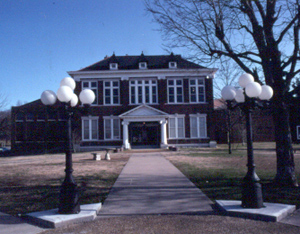
Cheatham County
The Tennessee General Assembly created Cheatham County on February 28, 1856, from parts of Davidson, Robertson, Montgomery, and Dickson Counties. The county name honors Edward Saunders Cheatham, Speaker of the state Senate. At the first county court meeting at Sycamore in May 1856, the commissioners purchased fifty acres of land on the north side of the Cumberland River from James Lenox for the establishment of Ashland City. Proceeds from the sale of town lots financed the construction of a courthouse and jail. The courthouse, completed in 1858, was replaced by a larger, brick structure in 1869. In 1886 a brick jail supplanted the original log jail; following a fire in 1935, it was rebuilt, and a new jail was erected in 1986.
Several archaeological sites, including ones listed on the National Register of Historic Places, document activities by Native Americans who once lived in the county. Early white settlers in the county established settlements at Sycamore, Pleasant View, and Ashland City. To provide for the safety of the first settlers, a blockhouse was erected at the fork of Half Pone and Raccoon Creeks.
In an effort to make education more widely available, the Tennessee General Assembly incorporated the Millwood Female Academy in 1852. Despite its name, males as well as females attended the school, which remained in operation until shortly after the Civil War. Millwood Institute, located at Sycamore Mills, became the largest private school in Cheatham County. Established in 1859, the school had closed by the end of the nineteenth century. Ashland Institute, established in 1880, Link School at Thomasville, founded in 1902 by S. A. Link, and Pleasant View School, opened in 1884 by W. I. Harper, also provided early educational opportunities.
The first significant manufacturer in the area was Montgomery Bell. In 1818 he blasted a tunnel through the Narrows of the Harpeth River to create a sixteen-foot fall of water. He erected two water wheels at this site to operate hammers for forging pig iron into pots, pans, kettles, and other iron products. The Narrows is now a state park, the Harpeth Scenic River and Narrows Historic Area.
In 1835 Samuel N. Watson established Sycamore Mills, located on Sycamore Creek four miles north of Ashland City. In 1842 he sold half-interest in the operation and five thousand acres of land to Richard Cheatham, at which time the name was changed to Cheatham, Watson and Company. The operation included a cotton gin, grist mill, and a powder mill, but the manufacture of gunpowder was the most important industry. As one of only two large powder mills in the South, Sycamore Mills became a target for both Federal and Confederate armies in the opening days of the Civil War. In 1862 it quickly came under Union control and suspended operations until the close of the war. In 1869 the Cheatham heirs sold their interest in the mills to the Sycamore Manufacturing Company. The company purchased the machinery of the destroyed Confederate Powder Works in Augusta, Georgia, and moved it to the mills in Cheatham County. In 1893 E. I. Du Pont de Nemours Company purchased the mills. At the time of the closing of the mills in 1904, the daily production had reached 400 kegs of powder.
Today Cheatham County retains its reputation as a manufacturing center. With 2,600 employees, State Industries of Ashland City is one of the world's largest suppliers of water heaters, producing 2.3 million heaters a year.
Early agriculture and industry depended on the Cumberland River and its tributaries. In 1897 the DuPont company at Sycamore Mills purchased a steamboat, rechristened the Sycamore, to haul gunpowder from Ashland City to Nashville. In 1848 the state chartered Hyde's Ferry Turnpike to extend from Nashville across the Cumberland River. The road remained in operation until 1916, when Cheatham County, following the lead of Davidson County, bought its portion of the road and freed it of tolls. By 1920 Cheatham County boasted twenty-eight miles of railway owned by the Nashville, Chattanooga, and St. Louis Railway and the Tennessee Central Railway. Today Interstates 24 and 40 and U.S. Highways 70 and 41A traverse the county. At Ashland City a new bridge over the Cumberland River has been recently finished to replace one built in 1931.
Cheatham County first acquired a local newspaper service in 1877 when H. B. Stewart established the Cheatham County Plaindealer. In 1896 William Thomas Clark bought the Reporter (established in 1883) and renamed it the Ashland City Times. This paper, which continues in operation, was purchased by Community Newspapers Incorporated in 1944 and resold to Multimedia of Greenville, South Carolina, in 1973.
In recent years animal wildlife has become a source of revenue for the county. The Tennessee Wildlife Resources Agency operates a game reserve of twenty-one thousand acres on the south side of the Cumberland River where deer, turkey, and small game are hunted in the appropriate hunting seasons.
Cheatham County's population grew by a third between 1990 and 2000, with most people working in industry and the services. But hundreds of families are still actively engaged in farming. Tobacco and beef cattle produce the county's largest farm incomes.
According to the 200O census, 35,912 people live in Cheatham County. In addition to the county seat of Ashland City, there are two other incorporated towns, Kingston Springs and Pegram. Two libraries, at least sixty churches, three high schools, and a hospital meet the educational, spiritual, and health needs of the county residents. Seven parks and two golf courses provide recreational opportunities. An active historical and genealogical association preserves the county's heritage.



